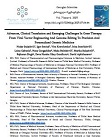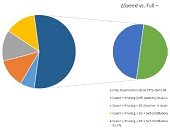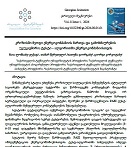REVIEW AND ANALYSIS OF PATRIMONIAL AND MERITOCRATIC GOVERNANCE CONCEPTS
Downloads
A theoretical and methodological approach of the paper is the analysis of general neopatrimonial and social network theories – to understand both the dominant trend and variations in reform trajectories in Georgian civil service. This work introduces the concepts of neopatrimonialism, bureaucracy, meritocracy and informal networks examining their origins and defining characteristics. This is followed by consideration of the nature of the public sector in Georgia, exploring the implications of neopatrimonialism for public sector capacity and performance. In setting up the contrast between neopatrimonial and meritocratic bureaucracies, we have chosen to emphasize two points that lend themselves to relatively objective empirical assessment. The first is the importance of meritocratic recruitment, ideally based on some combination of education and examination, second is a predictable career ladder, which provides long term tangible and intangible rewards for those who have been recruited into the bureaucracy.
Downloads
Metrics
Clapham, C. 1982. ‘Clientelism and the State’, in Clapham, C. (ed.) (1982) Private Patronage and Public Power. Political Clientelism and the Modern State (London, Frances Pinter), pp. 1–35.
Dahlstrom, C., Lapuente V., Teorell J. 2011. Dimensions of bureaucracy II: A cross-national dataset on the structure and behaviour of public administration. QoG (The Quality of Government Institute) Working Paper Series 2011:6.
Dimitrov, V., Goetz, K. H. and Wollmann, H. 2006. Governing after Communism. Institutions and Policymaking (Lanham, MD, Rowman and Littlefield Publishers).
Eisenstadt, S. N. 1973. Traditional Patrimonialism and Modern Neopatrimonialism (Beverly Hills, CA, Sage Publications).
Eisenstadt, S. N. and Roniger, L. 1984. Patrons, Clients and Friends. Interpersonal Relations and the Structure of Trust in Society (Cambridge, Cambridge University Press).
Emerson, R. M. 1972. ‘Exchange Theory, Part II: Exchange Relations and Networks.’ pp. 58-87 in Sociological Theories in Progress, edited by J. Berger, M. Zelditch, and B. Anderson. Vol. 2. Boston: Houghton Mifflin.
Erdmann, G. and Engel, U. 2007. ‘Neopatrimonialism Reconsidered: Critical Review and Elaboration of an Elusive Concept’, Commonwealth and Comparative Politics, 45, 1, pp. 95–119.
Erdmann, G. 2003: Neopatrimoniale Herrschaft - oder: Warum es in Afrika so viele Hybridregime gibt, in: Bendel, Petra et al. (eds.): Zwischen Demokratie und Diktatur. Opladen: Leske + Budrich, pp. 323-342
Evans, P. 1989. ‘Predatory, developmental, and other apparatuses: a comparative political economy.’ Sociological Forum 4(4): 561–587.
Fishman, R. M. 1990. ‘Rethinking State and Regime: Southern Europe’s Transition to Democracy’, World Politics, 42, 3, pp. 422–40.
Geddes, B. 1999. ‘What Do We Know About Democratization After Twenty Years?’. Annual Review of Political Science, 2, pp. 115–44.
Hanson St. E. 2010. Post-Imperial Democracies: Ideology and Party Formation in Third Re- public France, Weimar Germany, and Post-Soviet Russia. - Cambridge; N. Y.: Cambridge Univ. Press.
Hensell, S. 2009. Die WillkuЁr des Staates. Herrschaft und Verwaltung in Osteuropa (Wiesbaden, VSVerlag).
Hensell, S. 2012. The Patrimonial Logic of the Police in Eastern Europe, Europe-Asia Studies, 64:5, 811-833
Kitschelt, H., Mansfeldova, Z., Markowski, R. & Toґ ka, G. 1999. Post Communist Party Systems. Competition, Representation, and Inter-Party Cooperation (Cambridge, Cambridge University Press).
Magaloni, B. 2006. Voting for Autocracy: Hegemonic Party Survival and its Demise in Mexico. Cambridge: Cambridge University Press.
Migdal, J. S. & Schlichte, K. 2005. ‘Rethinking the State’, in Schlichte, K. (ed.) (2005) The Dynamics of States. The Formation and Crises of State Domination (London, Ashgate), pp. 1–40.
Oleinik, A. (ed.). 2009. Reforming the State without Changing the Model of Power? On Administrative Reform in Post-Socialist Countries (London, Routledge).
Shelley, L. I. 1999. ‘Post-Socialist Policing: Limitations on Institutional Change’, in Mawby, R. I. (ed.) (1999) Policing across the World. Issues for the Twenty-first Century (London, UCL Press), pp. 75–87.
Verheijen, T. 2007. ‘Public Administration in Post-Communist States’, in Peters, B. G. & Pierre, J. (eds) (2007) Handbook of Public Administration (Los Angeles, CA, Sage Publications), pp. 311–19.
Weber, M. 1947. The theory of social and economic organization. New York: The Free Press.
Weber, M. 1958. The three types of legitimate rule. Berkeley Publications in Society and Institutions, 4(1), 1‐11.
Weber, M. 1978. Economy and Society. An Outline of Interpretive Sociology [edited by G. Roth & C. Wittich] (Berkeley, CA, University of California Press).
Гидденс, Э. 1999. Социология. М.
Фисун, А.А. 2010. К переосмыслению постсоветской политики: неопатримониальная интерпретация. - Политическая концептология. – № 4. – С. 158-187.
Эйзенштадт, Ш.Н. 2002. Парадокс демократических режимов: хрупкость и изменяемость (I) // Полис. №2. С.72-73.

This work is licensed under a Creative Commons Attribution-NonCommercial-NoDerivatives 4.0 International License.















































































































































































































